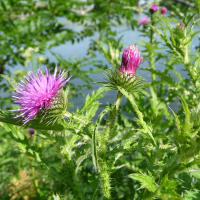Welted thistle
Carduus crispus
Carduus crispus, commonly known as Curly Plumeless Thistle, is a biennial or short-lived perennial plant belonging to the Asteraceae family. Native to Europe, it has become naturalized in various regions worldwide. Here's an informative description of this thistle species:
Description:
-
Plant Structure:
- Size: Curly Plumeless Thistle can grow to a height of 2 to 5 feet (60 to 150 cm).
- Growth Form: It has an erect, branching stem with spiny wings along the edges.
-
Leaves:
- Shape: The leaves are deeply lobed with spiny margins, giving them a distinctive, thistle-like appearance.
- Arrangement: Leaves are alternate along the stem.
-
Flowers:
- Inflorescence: The flowering head is a dense, spiny cluster of purple to pink tubular flowers.
- Flowering Season: Curly Plumeless Thistle typically blooms in late spring to early summer.
-
Spines:
- Spine Characteristics: The stem and leaves are armed with sharp spines or prickles.
Identification:
- Leaf Characteristics: The deeply lobed leaves with spiny margins are a key identifier.
- Flower Head: The dense, spiny cluster of flowers is distinctive.
Ecological Impact:
- Invasive Nature: Curly Plumeless Thistle is considered invasive in certain regions, where it can outcompete native vegetation and impact ecosystems.
- Habitat: It often colonizes disturbed areas, roadsides, and pastures.
Management:
-
Mechanical Control:
- Mowing: Regular mowing can prevent the formation of seed heads and control the spread.
- Hand Removal: Hand pulling or cutting the plants before they flower can be effective for small infestations.
-
Chemical Control:
- Herbicides: Selective herbicides can be used for larger infestations, following recommended guidelines.
-
Prevention:
- Early Detection: Early detection and rapid response are crucial to prevent the establishment of new infestations.
- Monitoring: Regular monitoring of areas prone to invasion.
Note: Curly Plumeless Thistle is considered a noxious weed in certain regions, and its control is important to protect native ecosystems and agricultural lands.










